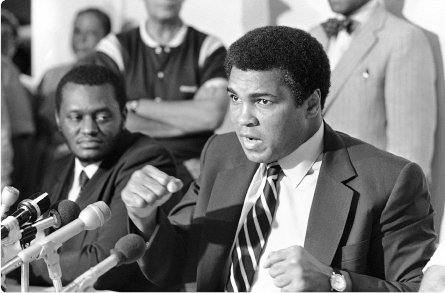Sharing Meaning

Muhammad Ali’s verbal communication skills have served important functions throughout his life, whether intimidating opponents or attracting supporters to his causes.
AP Photo/Phil Sandlin
The most obvious function verbal communication serves is enabling us to share meanings with others during interpersonal encounters. When you use language to verbally communicate, you share two kinds of meanings. The first is the literal meaning of your words, as agreed on by members of your culture, known as denotative meaning  . Denotative meaning is what you find in dictionaries—for example, the word bear means “any of a family (Ursidae of the order Carnivora) of large heavy mammals of America and Eurasia that have long shaggy hair” (Merriam-Webster Dictionary, 2011).
. Denotative meaning is what you find in dictionaries—for example, the word bear means “any of a family (Ursidae of the order Carnivora) of large heavy mammals of America and Eurasia that have long shaggy hair” (Merriam-Webster Dictionary, 2011).
But when we verbally communicate, we also exchange connotative meaning  : additional understandings of a word’s meaning based on the situation and the knowledge we and our communication partners share. Connotative meaning is implied, suggested, or hinted at by the words you choose while communicating with others. Say, for example, that your romantic partner has a large stuffed teddy bear that, despite its weathered and worn appearance, is your partner’s most prized childhood possession. To convey your love and adoration for your partner, you might say, “You’re my big ugly bear.” In doing so, you certainly don’t mean that your lover is big, ugly, or bearlike in appearance! Instead, you rely on your partner understanding your implied link to his or her treasured object (the connotative meaning). Relationship intimacy plays a major role in shaping how we use and interpret connotative meanings while communicating with others (Hall, 1997a): people who know each other extremely well can convey connotative meanings accurately to one another.
: additional understandings of a word’s meaning based on the situation and the knowledge we and our communication partners share. Connotative meaning is implied, suggested, or hinted at by the words you choose while communicating with others. Say, for example, that your romantic partner has a large stuffed teddy bear that, despite its weathered and worn appearance, is your partner’s most prized childhood possession. To convey your love and adoration for your partner, you might say, “You’re my big ugly bear.” In doing so, you certainly don’t mean that your lover is big, ugly, or bearlike in appearance! Instead, you rely on your partner understanding your implied link to his or her treasured object (the connotative meaning). Relationship intimacy plays a major role in shaping how we use and interpret connotative meanings while communicating with others (Hall, 1997a): people who know each other extremely well can convey connotative meanings accurately to one another.
Connotative meaning is implied, suggested, or hinted at by the words you choose while communicating with others.